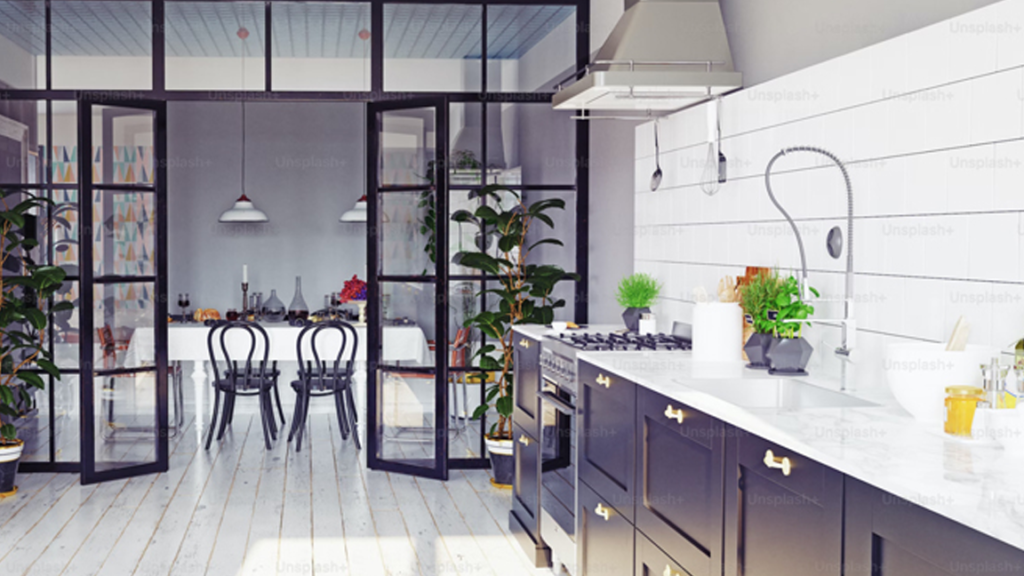
In part 1 of my blog series on interior lighting, I covered some fundamentals and design strategies for bringing warm lighting into the home; in this continuation piece, I will provide similar design strategies and insights. However, this article will focus on lighting from the other end of the spectrum, cool lighting!
To reiterate some of the science behind lighting from my last piece, cool lighting, also known as “daylight” or “cool white,” has a temperature of around 4500K to 6500K and emits a bluish-white to a clear white light that creates a more sterile and vibrant atmosphere. Generally, the lower the Kelvin (2700 up), the warmer the light; the higher the Kelvin (up to 6500), the whiter the light.
An example that we can all relate to is morning light is a higher kelvin of 4500-5000K or more, where the lighting is bright, clear, and fresh; the afternoon, known as the golden hour, is the perfect example of warmer light. As an interior designer and color specialist, I must consider all types of lighting, especially natural lighting that transitions throughout the day.
So, let’s discuss the strategy and application of cool lighting in the home!
Unlike warm lighting, which is better for setting a relaxing and inviting atmosphere without concern for long-term exposure, cool lighting has to be treated with more finesse and tact. Lighting impacts how our conscious and unconscious minds function; while warm lighting is soothing, cool lighting is energizing and invigorating, meaning most places in the home don’t call for much of it, if any.
The philosophy isn’t difficult to grasp when you envision the spaces in your home that require more focus/energy than the more neutral/relaxing spaces. Predominantly, cool lighting is best used as task lighting, which is lighting intended to improve visibility, provide greater detail, and limit eye strain when completing work.
Here are some of the most advantageous spaces to use cool lighting in your home:
The home office may be the most common form of task/cooler lighting in the home. Desktop lamps with cooler LED bulbs help people concentrate on work without losing focus or energy.
Cool lighting is not appropriate for all kitchen areas, but for the spaces of work/focus, such as countertops, stove tops, and preparation tables, under the counter lighting, cool lighting is highly effective. The cooler/bright light from fluorescent or LED bulbs mounted under cabinets is a great way to provide chefs with clear visibility; this lighting is much better for highlighting every detail, from the grain patterning on the steak to the vibrancy of color in a strawberry!
Similar to the task lighting needed in the kitchen for food prep, having cooler lighting in the laundry room is great for sorting laundry, identifying stains, and all of the other pleasantries that come with doing the laundry. You’re less likely to miss a spot with cooler task lighting overhead than warmer lighting by your side.
There’s a reason we surround ourselves with mirrors and high-intensity lighting in the bathroom, and it’s because we want to see every detail imaginable. Unless you’re in the bathtub looking to relax with candles by your side and jazz playing in the background, cooler lighting is the task lighting we all need to energize and best prepare ourselves for the day.
Overhead fluorescent lighting in closets of all types, even walk-ins, has been a go-to for years for interior designers. It is especially important to see the colors clearly so that everything matches when we leave home! Now, with more options like overhead LED track lighting, more homeowners expect cool lighting for their closets.
This is a newer trend in recent years, but avid gamers, editors, sound mixers, or really anyone who spends substantial time at a dedicated desktop for work or pleasure will enjoy the benefits of cooler lighting; this is mostly for the energy the light provides, but it also helps these minimalist areas appear cleaner/more focused.
Typically, this is the blog section where I suggest unique and fun ways to incorporate more of the design topic into your home, which is not the case with cool lighting. Unlike warm lighting, cool lighting is very much a utility and should only be used sparingly when needed for tasks. Unless you plan on installing a Tron-themed nightclub or bar in your home, cooler lighting isn’t to be dispersed here and there like warm accent lighting. Homes are meant to be warm, inviting, and relaxed, and too much cooler lighting can have the opposite effect!
Looking for a home that is relaxing with a soothing atmosphere? Then warm lighting is the right way to go. As with every blog post, I hope you learned something from these two posts, the first one being on warm lighting and this follow-up post and how cool lighting is used in your home. Stay tuned and come back for more; I have lots more topics on the drawing board!